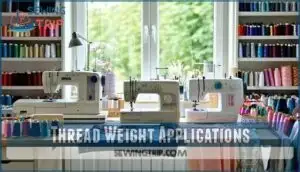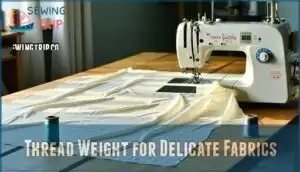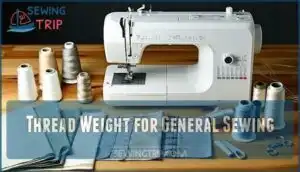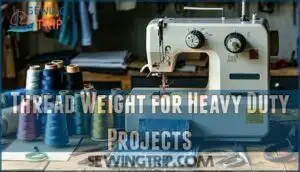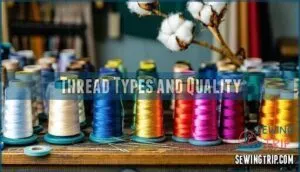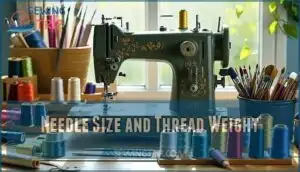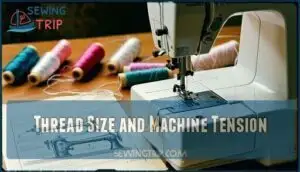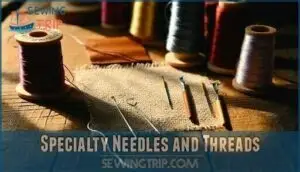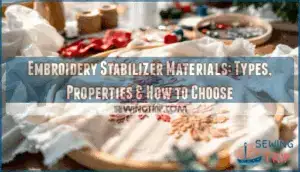This site is supported by our readers. We may earn a commission, at no cost to you, if you purchase through links.
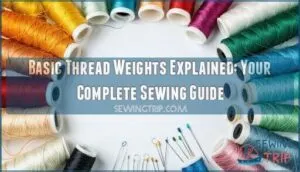 Thread weight measures how thick or thin your sewing thread is, but here’s the twist: higher numbers mean thinner threads.
Thread weight measures how thick or thin your sewing thread is, but here’s the twist: higher numbers mean thinner threads.
Think of it like wire gauges – a 50-weight thread is much finer than a 12-weight thread.
You’ll use lighter weights (40-50) for delicate fabrics like silk, medium weights (30-40) for everyday cotton projects, and heavy weights (12-20) for denim or upholstery.
The weight affects everything from how your stitches look to which needle size you’ll need.
Most sewers stick with 40-weight polyester for general use since it’s forgiving and versatile.
Understanding this numbering system opens up a whole world of professional-looking results you might not have known were possible.
Table Of Contents
Key Takeaways
- Higher numbers mean thinner threads – You’ll need to remember that 50-weight thread is much finer than 30-weight thread, which is the opposite of what you’d expect.
- Match thread weight to your fabric type – You’ll use 40-50 weight for everyday cotton projects, 60+ weight for delicate fabrics like silk, and 12-30 weight for heavy materials like denim.
- Adjust your needle size with thread weight – You’ll need a needle eye that’s 40% larger than your thread diameter; plus, you’ll have to change your machine’s tension settings when switching thread weights.
- Start with 40-weight polyester for versatility – You’ll find this weight works for most general sewing projects, and it’s forgiving enough to help you learn proper thread selection.
Thread Weight Basics
Understanding thread weight doesn’t have to be confusing once you grasp the basic numbering system.
Higher thread weight numbers actually mean thinner threads, so 50-weight thread is much finer than 30-weight thread.
Remember: higher numbers mean thinner threads, not thicker ones.
Thread Weight Measurement
Thread weight measurement can initially seem confusing, but understanding the basic principle makes everything clearer.
The weight conversion system uses a counterintuitive approach where higher numbers actually indicate thinner threads, while lower numbers represent thicker, denser threads.
- 30 weight thread appears thicker and heavier than 50 weight thread
- Thread density directly affects how your stitches will look and perform
- Metric systems like tex and denier provide alternative measurement tools
- Thread weight numbers create a standardized system across different brands and manufacturers
Thread Weight Systems
Different thread weight systems can confuse sewers, but understanding them simplifies your project planning.
The U.S. weight system uses higher numbers for finer threads, while Tex and Denier systems work oppositely.
Thread weight conversion between metric systems requires charts since each measures differently.
Legacy systems like English Count still appear on vintage spools.
Standardization efforts help, but system accuracy depends on consistent thread measurement systems and proper thread numbering system identification.
A smaller number indicates a heavier thread when using the thread weight system, which is an important concept for thread weight and understanding that the U.S. system is based on finer threads having higher numbers, and this affects thread measurement.
Denier and Tex Systems
Beyond the basic weight system, denier and tex systems offer precise thread weight measurement systems for industry standards.
Denier measures grams per 9,000 meters, while the tex system calculates grams per 1,000 meters.
Higher denier conversion and tex conversion numbers indicate thicker threads, providing measurement accuracy advantages over traditional weight guides.
Thread Weight Applications
Now that you understand thread weight basics, you’ll need to know which weights work best for different sewing projects.
The right thread weight can make the difference between professional-looking results and frustrating mishaps that leave you wondering why your stitches look uneven or your fabric puckers, which can be a significant issue affecting the overall quality of your sewing, making complete concepts of thread weight crucial.
General Sewing Thread Weights
Most sewers find success with these common thread weights for apparel thread projects.
Find your sweet spot with 40-50 weight threads for most sewing success.
Your fabric matching becomes simpler when you understand how thread durability affects stitch appearance based on your project needs.
Here’s your thread weight guide for everyday sewing:
- 50-weight threads – Perfect all-purpose choice for cotton, polyester blends, and lightweight fabrics
- 40-weight threads – Ideal for medium-weight materials like denim, canvas, and structured garments
- 60-weight threads – Best for delicate fabrics requiring subtle seams and invisible mending
These sewing thread types cover most apparel construction.
Remember, your thread weight chart shows that matching thread sizes explained here to fabric weight creates professional results every time.
Quilting Thread Weights
Quilting projects demand specific thread weight considerations for ideal results.
You’ll want 50wt thread for piecing quilt blocks since its fine diameter reduces seam bulk and improves point alignment.
For machine quilting, 40wt thread creates prominent decorative stitches with excellent thread visibility without overwhelming your fabric designs.
Hand quilting typically uses thicker 28wt threads for pronounced stitch definition, while coated cotton threads enhance durability and reduce friction during the quilting process.
Understanding the thread weight basics is essential for achieving the desired seam strength and visual appeal in your quilting projects.
Heavy Duty Thread Weights
Heavy duty threads tackle your toughest projects with superior strength and thickness.
When standard thread won’t cut it, these powerhouses handle canvas, denim, and upholstery with ease. Industrial sewing demands require robust thread weight numbers for lasting results.
You can find various types available for different projects.
- Canvas Thread (Tex 70-135) – Powers through heavy canvas bags and outdoor gear
- Denim Thread (12-28 weight) – Conquers thick seams and reinforced stitching
- Upholstery Thread (V92-V138) – Secures furniture fabric under constant stress
- Topstitching Thread (30 weight) – Creates bold, visible seams on leather jackets
Choosing Thread Weight
Choosing the right thread weight can make or break your sewing project. You’ll want to match your thread thickness to your fabric weight and project goals for professional-looking results.
Thread Weight for Delicate Fabrics
Delicate fabrics demand a gentle touch, and your thread weight for delicate fabrics makes all the difference.
Use 60-100 weight threads for silk thread weight projects, organza thread choice needs, and chiffon thread selection.
Fine thread types prevent fabric distortion while micro quilting threads create invisible stitches.
Adjust fine thread tension carefully—these gossamer threads require lighter machine settings to avoid snapping.
Thread Weight for General Sewing
Most general sewing projects thrive with 40-50 weight threads, your go-to choice for everyday fabric compatibility.
These medium-weight threads balance stitch visibility and seam durability perfectly, whether you’re working with cotton, polyester, or blends.
This thread weight range handles most fabrics without requiring major tension adjustments, delivering consistent results across various thread materials and project types.
It’s the reliable middle ground that guarantees the best results, and proper thread selection requires understanding thread weight measurement to achieve this.
Thread Weight for Heavy Duty Projects
When tackling canvas, denim, or leather projects, you’ll need threads that won’t snap under pressure.
Heavy-duty thread weights from 12-28 work best for these demanding materials.
Canvas thread and upholstery threads offer the thread strength needed for thick fabrics, while denim weight threads handle multiple layers beautifully.
Adjust your heavy-duty tension settings to match the thread thickness for maximum thread durability.
Thread Types and Quality
Thread quality matters just as much as weight when choosing the right thread for your project.
You’ll find that cotton offers natural breathability and easy handling, while polyester delivers superior strength and color retention that won’t fade over time.
Cotton Thread Characteristics
Cotton thread brings reliable strength and natural fiber quality to your sewing projects.
You’ll find 100% cotton offers excellent thread durability, while cotton blends combine cotton’s breathability with synthetic resilience.
The yarn texture feels smooth under your fingers, making it perfect for quilting and general construction.
Cotton’s natural properties create consistent stitches across various thread weight applications, from delicate piecing to bold topstitching in your thread weight guide.
Polyester Thread Characteristics
Polyester’s reputation for toughness makes it a go-to choice for high-stress sewing projects.
This synthetic powerhouse offers superior Polyester Durability compared to natural fibers, withstanding repeated washing and wear without breaking down.
Key polyester thread advantages:
- Fiber Strength resists snapping under machine tension
- Chemical Resistance prevents color fading from detergents
- Thread Blends with cotton combine durability and softness
- Consistent Yarn Texture maintains uniform stitching quality
Thread Finish and Color
Beyond aesthetics, thread finish and color affect your project’s durability and appearance.
Mercerized finishes boost cotton’s strength and luster, while glazed coatings add abrasion resistance.
Color fastness prevents bleeding and fading during washing.
Choose neutral hues for versatile color matching, or select vibrant shades for accent work that maintains color retention through multiple washes.
Thread Weight and Needle Compatibility
You’ll need to match your needle size to your thread weight for smooth, professional stitching—the needle eye should be about 40% larger than your thread’s diameter.
When you switch thread weights, you’ll also need to adjust your machine’s tension settings to prevent loops, puckering, or thread breakage, and ensure professional stitching.
Needle Size and Thread Weight
With the right needle selection, your thread weight and needle size work together like dance partners.
Choose a needle with an eye 40% larger than your thread diameter to prevent fraying and guarantee smooth stitching.
Thicker threads need larger needle eyes, while fine threads work best with smaller needles.
This proper pairing improves sewing efficiency and delivers superior stitch quality every time.
Understanding the correct sewing thread needles is vital for achieving professional results with sewing thread types.
Thread Size and Machine Tension
When you change thread weight, your machine’s tension needs adjustment.
Heavier threads require looser tension to prevent thread breakage, while lighter threads need tighter settings for proper stitch quality.
Test on fabric scraps first – improper tension control causes skipped stitches, puckering, or poor fabric compatibility.
Machine settings directly impact your project’s success.
Understanding proper thread tension basics is essential for achieving the right balance and preventing common sewing issues, as explained in the thread tension basics guide, which helps in maintaining proper stitch quality and avoiding common sewing issues with the right thread weight.
Specialty Needles and Threads
Some threads demand specialized needles for best results.
Topstitching needles have enlarged eyes that accommodate 12-30 weight decorative threads without fraying.
Leather needles feature chisel points for piercing tough materials.
Microtex needles work perfectly with 100 weight threads for micro stitching and delicate embroidery threads.
Choose your needle based on thread weight and fabric type.
Selecting Best Thread Weight
You’ll need to take into account both thread weight and material type when choosing the right thread for your project.
The key is matching your thread’s characteristics to your fabric’s weight and your project’s specific requirements.
Considering Thread Weight and Type
Your thread selection depends on matching thread weight to your fabric choice and sewing techniques.
Light fabrics need 60-80 weight threads, while heavy materials require 12-30 weight options.
Consider thread thickness when adjusting thread tension for superior stitch quality.
Cotton threads work best for natural fabrics, polyester for synthetics.
Understanding thread weights helps you choose the right thread weight for professional results.
Considering Thread Brand and Quality
Beyond thread weight, brand reputation and fiber quality matter just as much for your sewing success.
Leading brands like Gutermann, Coats & Clark, and Mettler offer consistent color consistency and superior material selection.
Quality thread labels help you identify reliable options that reduce lint, prevent breakage, and maintain professional thread finishes across projects, ensuring consistent color consistency.
Experimenting With Thread Weights
Don’t be afraid to mix things up with different thread weights on a single project.
Testing various combinations on fabric scraps helps you discover what works best. Try contrasting thread weights for unique texture effects – a heavy decorative thread on top with lightweight bobbin thread creates stunning results.
Remember to adjust your thread tension and stitch length when switching weights. Color matching becomes easier when you understand how thread thickness affects appearance.
Understanding the right thread weight systems is essential for achieving professional-looking stitches and ensuring the longevity of your sewing projects. This involves considering the thread weight and its impact on the overall appearance of your work, leading to better results with the right techniques.
Frequently Asked Questions (FAQs)
Which is heavier, 40 wt or 50 wt thread?
Like choosing between two puzzle pieces, you’ll find 40 wt thread is heavier than 50 wt thread. Remember, smaller weight numbers mean thicker, heavier threads in the sewing world.
What do different thread weights mean?
Numbers tell the story backwards: lower numbers mean heavier threads.
You’ll find 30-weight thread is thicker than 50-weight. Think of it as measuring how much thread fits in a kilogram—less thread means it’s chunky.
What is the difference between 30 wt and 40 wt thread?
30 weight thread is thicker than 40 weight thread. You’ll notice 30 weight creates more prominent, visible stitches while 40 weight produces finer, subtler stitching on your projects.
What is the difference between 60 wt and 90 wt bobbin thread?
60 weight bobbin thread is thicker than 90 weight – remember, higher numbers mean thinner threads. 60wt works for general embroidery, while 90wt’s ultra-fine for delicate work.
Can different thread weights mix in same project?
Mixing threads feels like blending paint colors—you’ll create beautiful effects with intention.
Yes, you can combine different weights strategically.
Use heavier threads for topstitching visibility, lighter ones for construction seams, ensuring proper needle adjustments with visibility.
How does thread weight affect washing durability?
Heavier threads withstand washing better than fine ones. They’re less likely to break, fray, or weaken during agitation cycles, making your stitches more durable over time.
What causes thread weight inconsistencies between brands?
Manufacturing inconsistencies stem from different measurement standards and fiber quality variations.
You’ll encounter weight differences because brands use cotton versus polyester blends, varying twist levels, and distinct manufacturing processes that affect final thread density.
Does thread weight impact embroidery hoop selection?
Thread weight doesn’t directly impact hoop selection, but it affects stitch density and tension.
You’ll need to adjust your embroidery settings and possibly use larger needles with heavier threads to prevent bunching or breaking, which can be influenced by thread weight.
Can vintage thread weights match modern equivalents?
Like comparing apples to oranges, vintage thread weights don’t always match modern standards.
You’ll find vintage threads often used different measurement systems, making direct comparisons tricky.
Check labels carefully and test compatibility first, to ensure complete concepts are understood and to avoid any potential issues with vintage threads.
Conclusion
Mastering basic thread weights explained is like learning to read a roadmap for your sewing journey.
You’ll discover that matching thread weight to your fabric and project type transforms your finished results from amateur to professional quality.
Start with 40-weight polyester for most projects, then experiment with lighter weights for delicate fabrics and heavier weights for sturdy materials.
Remember that thread weight directly affects needle selection and machine tension settings.
With practice, you’ll intuitively choose the right weight every time, and matching thread weight to your fabric and project type will become second nature, leading to a more finished results.

